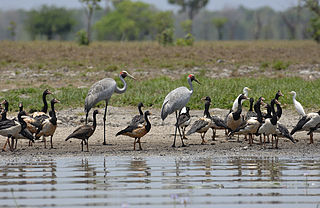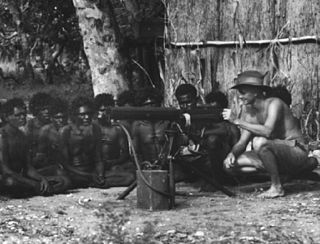
Arnhem Land is a historical region of the Northern Territory of Australia, with the term still in use. It is located in the north-eastern corner of the territory and is around 500 km (310 mi) from the territory capital, Darwin. In 1623, Dutch East India Company captain Willem Joosten van Colster sailed into the Gulf of Carpentaria and Cape Arnhem is named after his ship, the Arnhem, which itself was named after the city of Arnhem in the Netherlands.

The Yolngu or Yolŋu are an aggregation of Aboriginal Australian people inhabiting north-eastern Arnhem Land in the Northern Territory of Australia. Yolngu means "person" in the Yolŋu languages. The terms Murngin, Wulamba, Yalnumata, Murrgin and Yulangor were formerly used by some anthropologists for the Yolngu.

Edward Joseph Egan is an Australian folk musician and a former public servant who served as Administrator of the Northern Territory from 2003 to 2007.
The Gove Peninsula is at the northeastern corner of Arnhem Land in the Northern Territory of Australia. The peninsula became strategically important during World War II when a Royal Australian Air Force base was constructed at what is now Gove Airport. The peninsula was involved in a famous court case known as the Gove land rights case, when local Yolngu people tried to claim native title over their traditional lands in 1971, after the Australian Government had granted a mineral lease to a bauxite mining company without consulting the local peoples. Today the land is owned by the Yolngu people.

Makassar people from the region of Sulawesi in Indonesia began visiting the coast of Northern Australia sometime around the middle of the 18th century, first in the Kimberley region, and some decades later in Arnhem Land. They were men who collected and processed trepang, a marine invertebrate prized for its culinary value generally and for its supposed medicinal properties in Chinese markets. The term Makassan is generally used to apply to all the trepangers who came to Australia.
The Wessel Islands is a group of uninhabited islands in the Northern Territory of Australia. They extend in a more or less straight line from Buckingham Bay and the Napier Peninsula of Arnhem Land, and Elcho Island, to the northeast. Marchinbar Island is the largest of the group. Other islands include Elcho Island, Rimbija Island, Guluwuru, Raragala, Stevens Island, Burgunngura, Djeergaree, Yargara, Drysdale Island, Jirrgari Island, Graham Island, Alger Island, Abbott Island, and Howard Island.
The Caledon Bay crisis refers to a series of killings at Caledon Bay in the Northern Territory of Australia during 1932–34, referred to in the press of the day as Caledon Bay murder(s). Five Japanese trepang fishers were killed by Aboriginal Australians of the Yolngu people. A police officer investigating the deaths, Albert McColl, was subsequently killed. Shortly afterwards, two white men went missing on Woodah Island (with one body found later). With some of the white community alarmed by these events, a punitive expedition was proposed by Northern Territory Police to "teach the blacks a lesson".
Caledon Bay is a bay in Arnhem Land, in the Northern Territory of Australia, at approximately 12.8° S, 136.5° E. It is perhaps most famous as the home of a group of Yolngu people who were key players in the Caledon Bay crisis, which marked a turning point in the relationship between Indigenous and non-Indigenous Australians.

Donald Finlay Fergusson Thomson OBE was an Australian anthropologist and ornithologist. he is known for his studies of and friendship with the Pintupi and Yolngu peoples, and for his intervention in the Caledon Bay crisis.

Yirrkala is a small community in East Arnhem Region, Northern Territory, Australia, 18 kilometres (11 mi) southeast of the large mining town of Nhulunbuy, on the Gove Peninsula in Arnhem Land. Its population comprises predominantly Aboriginal Australians of the Yolngu people, and it is also home to a number of Mission Aviation Fellowship pilots and engineers based in Arnhem Land, providing air transport services.
Bickerton Island is 13 km west of Groote Eylandt and 8 km east of the mouth of Blue Mud Bay in eastern Arnhem Land, in the Northern Territory of Australia. It is about 21 by 21 kilometres in size, with deep bays and indentations, and has an area of 215 km2. The largest bays are South Bay and North Bay. Bickerton Island was named by Matthew Flinders for Admiral Sir Richard Bickerton, Bt.

The Australian frontier wars were the violent conflicts between Indigenous Australians and primarily British settlers during the colonial period of Australia.

Blue Mud Bay is a large, shallow, partly enclosed bay on the eastern coast of Arnhem Land, in the Northern Territory of Australia, facing Groote Eylandt on the western side of the Gulf of Carpentaria. It lies 580 km (360 mi) east-south-east of Darwin in the Arnhem Coast bioregion. Its name was given to a landmark court ruling affirming that the Aboriginal traditional owners of much of the Northern Territory's coastline have exclusive rights over commercial and recreational fishing in tidal waters overlying their land.

Tuckiar v The King is a landmark 1934 judgment of the High Court of Australia. The matter examined the behaviour of the judge and lawyers in the trial of Yolngu man Dhakiyarr (Tuckiar) Wirrpanda in the Northern Territory Supreme Court a year earlier for one of the Caledon Bay murders, and overturned the judgment which had found the appellant guilty and sentenced him to death.

The Northern Territory Special Reconnaissance Unit (NTSRU) was an irregular warfare unit of the Australian Army during World War II, composed mainly of Aboriginal people from the Northern Territory. Formed in 1941, the unit patrolled the coast of Arnhem Land during 1942–43 searching for signs of Japanese landings and trained to fight as guerrillas using traditional weapons in the event of an invasion. In 1943, as the war moved northward from the Australian coast, the NTSRU was disbanded.

The Anindilyakwa people (Warnumamalya) are Aboriginal Australian people living on Groote Eylandt, Bickerton Island, and Woodah Island in the Gulf of Carpentaria in the Northern Territory of Australia.
The Dhuwal are an indigenous Australian people of Arnhem Land in the Northern Territory
Thomas Alexander Wells was a judge of the Northern Territory Supreme Court in Darwin, Australia. He was known for having misdirected the jury in a high-profile case in 1934, which was later overturned in an appeal in the High Court of Australia known as Tuckiar v The King.
Wonggu Mununggurr (c.1880–1959) was an Aboriginal Australian artist and leader of the Djapu clan of the Yolngu people of northeast Arnhem Land in the Northern Territory of Australia.
Bäniyala is a tiny community of Aboriginal Australian people, known as a homeland, situated on Blue Mud Bay in the Gulf of Carpentaria in East Arnhem Land in the Northern Territory of Australia, located 210 kilometres (130 mi) from Nhulunbuy. It is home to about 150 Yolŋu people.











